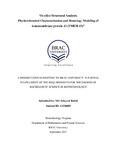| dc.contributor.advisor | Mohammad, Eusra | |
| dc.contributor.author | Rabbi, Mir Sohayeb | |
| dc.date.accessioned | 2018-01-28T09:59:04Z | |
| dc.date.available | 2018-01-28T09:59:04Z | |
| dc.date.copyright | 2017 | |
| dc.date.issued | 2017-09 | |
| dc.identifier.other | ID 13336003 | |
| dc.identifier.uri | http://hdl.handle.net/10361/9269 | |
| dc.description | This thesis is submitted in partial fulfillment of the requirements for the degree of Bachelor of Science in Biotechnology, 2017 | en_US |
| dc.description | Cataloged from PDF version of thesis report. | |
| dc.description | Includes bibliographical references (pages 80-84). | |
| dc.description.abstract | Arrhythmogenic right ventricular cardiomyopathy (ARVC) is a rare disease of the heart muscle. ARVC is an inherited condition, which means that it is passed on through families. It is caused by a change or mutation in one or more genes. ARVC can result from mutations in at least eight genes and each mutation is related to different types of ARVC. Many of these genes are involved in the function of desmosomes, which are structures that attach heart muscle cells to one another. Mutations in the genes responsible for ARVC often impair the normal function of desmosomes. Without normal desmosomes, cells of the myocardium detach from one another and die. One of the mutations responsible for a specific type of this disease is called ARVC type 5. A heterozygous missense mutation in the transmembrane protein 43 (TMEM 43) gene, (Ser358Leu) has been genetically identified to cause autosomal dominant ARVC type 5. Although TMEM 43 is an inner nuclear membrane protein, its presence at the intercalated discs has been confirmed. It is an integral membrane protein that spatially and functionally organizes protein complexes of the inner nuclear membrane and, therefore, has the potential to cause pathological changes of the nuclear envelope. However, the exact mechanism by which this protein carries out its function is yet unknown due to limited research on this area. A 3D structure of this protein is yet to be developed which would have facilitated understanding the function of this protein. Thus it is necessary to determine the structure of the protein encoded by TMEM 43 gene which could help to unravel how it interacts with other proteins at the inner nuclear membrane. The aim of this study is to predict the three-dimensional structure of transmembrane protein 43 via homology modeling and to examine its physicochemical properties using in silico approaches. Bio-computational analyzes of the target protein were performed using an array of online bioinformatics tools and databases and the homology model was developed using two different software programs (I-TASSER and SwissModel), whereby the best model was selected upon evaluation. In addition, the secondary structural motifs were identified within the model. This project provides an insight about the possible functions of the protein in maintaining nuclear envelope, given that further research is performed to prove its acceptance and efficiency. | en_US |
| dc.description.statementofresponsibility | Mir Sohayeb Rabbi | |
| dc.format.extent | 84 pages | |
| dc.language.iso | en | en_US |
| dc.publisher | BRAC University | en_US |
| dc.rights | BRAC University thesis reports are protected by copyright. They may be viewed from this source for any purpose, but reproduction or distribution in any format is prohibited without written permission. | |
| dc.subject | Structural analysis | en_US |
| dc.subject | Homology theory | en_US |
| dc.title | In silico structural analysis, physicochemical characterization and homology modeling of transmembrane protein 43 (TMEM 43) | en_US |
| dc.type | Thesis | en_US |
| dc.contributor.department | Department of Mathematics and Natural Sciences, BRAC University | |
| dc.description.degree | B. Biotechnology
| |

